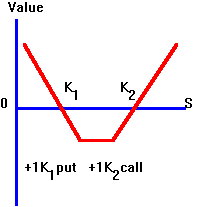8.5
Combination Position Strategies
As
the name implies, combinations are portfolios of both puts and calls.
These come with colorful names such as straddles, strangles, strips, and
straps. Typically, combinations are
used either when you expect price stability or you expect volatility, but with
neutral expectations about the
direction of price movements.
A
straddle consists of buying a put and a call with the same strike price. As shown in Figure 8.14, this strategy makes money
if the stock price either falls a lot or rises a lot, and loses money if
it stays unchanged.
Figure 8.14
Straddle

Since
a straddle is profitable when prices are volatile, buying a straddle is
sometimes called buying volatility. Note
that a straddle writer profits from price stability, and is thus "selling
volatility." A cheaper
alternative to buying a straddle is a strangle,
where you buy a lower strike-price put and a higher strike-price call. This strategy
is cheaper, because both the options are less likely to be in-the-money.
A strangle is shown in Figure 8.15.
Figure 8.15
Strangle

By
varying the ratio of puts and calls in these combination strategies, you can
gain more steeply from a price increase or from a price fall.
A strip is a variation on a
straddle, where you buy more puts than calls.
This strategy makes relatively more with price declines than with price
rises.
A
strap is the opposite of a strip; you buy more calls than puts.
Virtually
any payoff desired can be constructed by combining options appropriately, although some of these combinations may be difficult to
achieve because there is insufficient liquidity.
In fact, for most stocks, a relatively small number of options are
actually traded (those with strike prices near the current stock price).
 office (412)
9679367
office (412)
9679367